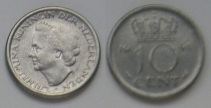 | ||
A dubbeltje ( [ˈdɵbəlcə]) is a small former Dutch coin, originally made of silver, with a value of a tenth of a Dutch guilder. The 10 euro-cent coin is currently also called a dubbeltje in the Netherlands.
Contents
The name "dubbeltje" is the diminutive form of the Dutch word "dubbel" (Dutch for "double") because it was worth two stuivers. When the decimal system came to the Netherlands (about 1800) the 10 cent coin was named a "dubbeltje". Before the euro came, the dubbeltje was the world's smallest coin in use; it weighed 1.5 grams. Formerly in the Netherlands the silver stuiver (0.685 gram) and the halfje (1.25 gram) were smaller.
In Dutch slang a dubbeltje was named a beisje, from Dutch-Yiddish beis, the value of two stuivers.
The central opening in a CD is exactly the size of a dubbeltje. Joop Sinjou, head of Philips audio products development, said that "De snelste beslissing in de ontwikkelingsfase was over de diameter van het gat in de cd. Ik legde een dubbeltje op tafel en dat werd de maat." ("The fastest decision in the development phase was about the diameter of the hole in the CD. I put a dubbeltje on the table and that was the size.")
There are Dutch sayings about the dubbeltje:
Automatic translation from Dutch to English often translates "dubbeltje" as "dime".
Dimensions and weight
Source
Versions
Source
